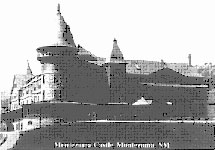Montezuma Castle
Client: Armand Hammer United World College of the American West
Site: Montezuma, New Mexico

The Montezuma Castle, originally known as the Montezuma Hotel, was designed by noted Chicago architects John Root and Daniel Burnham for the Atchinson, Topeka and Santa Fe Railroad in the early 1880s. For a decade, the hotel operated as a resort, serving as a major attraction for many noteworthy visitors including, Presidents Rutherford B. Hayes, Ulysses S. Grant, Theodore Roosevelt, and General William Tecumseh Sherman. Closed in 1903, the hotel was later purchased by the Catholic Church, who operated a seminary for Mexican priests there from 1937-1972. After the seminary was closed by the church, the Castle was left empty and easy prey to vandalism. In 1981, the Armand Hammer Foundation bought the property and founded the United States Campus of United World Colleges.
The Castle remained an empty but picturesque backdrop to the UWC-USA campus until 1997, when it garnered national attention. First, the National Trust for Historic Preservation recognized the building as one of America's most endangered historic places. In 1998, the White House Millennium Council named it one of “America’s Treasures,” the first property west of the Mississippi to receive that honor. In 1998, the UWC-USA launched its first capital campaign, “Save the Castle-Serve the World,” raising funds for the restoration of Montezuma Castle. Structural problems, exacerbated by attempts to shore up the long trusses over the original ballroom, plus building code violations, had kept the building from being a fully functioning part of the campus. As a result of this, our firm was selected to perform a Historic Structures Report. We evaluated the historical and architectural significance of the Castle, the physical condition of the building’s materials and systems, and the limitations for contemporary use considering building code requirements, and original construction techniques. Using this information, two utilization plans were prepared. The first was for an independent hotel operator to reopen the hotel as a summer resort during the college’s off-season. The second plan was for the integration of college functions into the building, after determining those functions that would best fit into the structure, with the least amount of impact to the historical and architectural integrity. Cost estimates for each alternative plan were provided, and the College has since, repaired, and restored this notable historic landmark.
